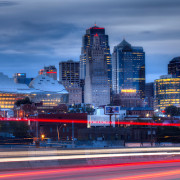Office Summit program illustrates opportunities in Downtown
Courtesy of Kevin Collison, CityScene KC
Lack of a big chunk of premier, new office space likely cost Downtown Kansas City a major Starbucks operation with 900 jobs last summer, and how to address that challenge was the focus recently of the second annual Downtown Office Summit.
Mayor Sly James kicked off the Oct. 17th summit – organized by the Downtown Council – by citing the accomplishments of recent years in revitalizing Downtown.
“We’re building cities for the future, for our kids,” he told the sold-out audience of more than 250 people at the BNIM offices in Crown Center. “One key is our ability to attract talent. People go where they want to live and Kansas City is moving up that chart at an extremely rapid pace. We are a city on the rise and people are taking notice.”
But while Downtown has benefited greatly from a boom in apartment, hotel, entertainment and restaurant investment in recent years, office development continues to lag. The last big new office building to go up here was the H&R Block building in 2006 and it was done for its namesake tenant.
“Starbucks representatives were “blown away by how cool (Downtown) Kansas City was and what’s happening here” and was runner-up in the firm’s extensive national search, according to Tim Cowden, president and CEO of the Kansas City Area Development Council.
But Starbucks needed 100,000 square feet of Class A space relatively quickly, and it would take 18 to 24 months to build it in Downtown KC. Starbucks went to Atlanta instead, where there’s already “four- to five cranes in the air.”
Members of the Office Summit development panel said Downtown is ripe for new office construction, pointing to a steady decline in vacancy rates, but differed on just how soon and how big the next wave of activity will be.
Vince Bryant, whose 3D Development firm partnered with Copaken Brooks on the most recent big office project, the renovation of the 10-story Corrigan Station building, believes Downtown should be adding 700,000 square feet of office space annually just to keep up with the residential boom.
Instead, about 700,000 square feet has been done in the past four to five years. Bryant is currently pursuing the redevelopment of the historic Kansas City Star building, a 275,000 square-foot project.
“There hasn’t been a new spec office building built Downtown since 1987 and that’s something we ought to figure out how to change,” Bryant said. “I view the Downtown market as having its historical stock drying up, most buildings have been renovated. The next phase is new construction.”
The biggest new downtown office project in the works currently is being planned by Platform Ventures on a site across from Barney Allis Plaza at 13th and Wyandotte. An earlier concept called for 70,000 square feet, but Terry Anderson of Platform said it could grow up to 120,000 square feet.
“We’re very optimistic,” Anderson said.
The kind of big skyscrapers that were built however in the 1980s and 1990s, such as One Kansas City Place and the Town Pavilion, are problematic.
Tim Schaeffer, president of AREA Real Estate Advisors, said lenders are much more strict now, and demand 40 to 50 percent of buildings be pre-leased before providing financing.
“I don’t believe the confidence is there yet for lenders to say ‘let’s do this,’” Schaeffer said.
Developers estimated it would take rents of $34-$35 per square foot to spur new construction. Currently, rates at Corrigan Station, one of Downtown’s premier addresses, are in the $25- to $30 range, Bryant said.
Development attorney Jerry Riffel, another panelist, said it will require some boldness to change the Downtown office status quo.
“Somebody is going to have to jump out,” he said. “We’ve got something to sell and good locations, we need to talk about being proactive.”
Bryant suggested a proposed River Market office site controlled by the Kansas City Area Development Authority at Third and Grand could have been ideal for Starbucks—if development of a parking garage had been underway.
“Third and Grand would have been a perfect location for them,” he said.
“If that garage project was a year ahead of schedule, they might have waited 12 or 18 months knowing it was the ideal building they wanted.”

The Downtown office vacancy rate has been declining in recent years.
Schaeffer observed that Downtown Kansas City always has been a more affordable place for firms on either Coast, but until recently didn’t have the quality of life to close the deal.
“Now we have a cool city where young people want to stay and live, our city is entirely different from what I could have envisioned 10 years ago,” he said.
As to where a sizable new office project might occur next, Schaeffer believes property controlled mostly by Copaken Brooks west of Broadway between Southwest Boulevard and I-670 would be attractive because of its eligible for hefty federal tax breaks.
Anderson was skeptical about the prospects for high-rise construction within the Downtown Loop, saying a more modest, 50,000 to 75,000 square foot project could occur in the Crossroads or East Village areas.
But Riffel was bullish on going big.
“The next high-rise is more likely to be in the Power & Light District,” he said. “I think there will be one.”
And panelist Stacy Paine, CEO of Crown Center Redevelopment, said vacant property her firm recently offered for development along 27th Street between Grand and Main is ripe for something larger.
“It’s right along the streetcar and walkable from new apartments and Crown Center,” she said. “I think it will be bigger than 50,000 or 60,000 square feet.”
Bryant added, “We’re all rooting for new construction and new office because that pulls the price point up to $34-$35.”
Don’t miss any Downtown news, sign up for the weekly CityScene KC email review here.

